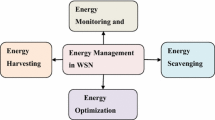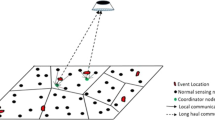Abstract
Wireless sensor networks are poised for increasingly wider uses in many military and civil applications. Such applications has stimulated research in a number of research areas related to energy conservation in such networks. Most such research focuses on energy saving in tasks after the network has been organized. Very little attention has been paid to network bootstrapping as a possible phase where energy can be saved. Bootstrapping is the phase in which the entities in a network are made aware of the presence of all or some of the other entities in the network. This paper describes a bootstrapping protocol for a class of sensor networks consisting of a mix of low-energy sensor nodes and a small number of high-energy entities called gateways. We propose a new approach, namely the slotted sensor bootstrapping (SSB) protocol, which focuses on avoiding collisions in the bootstrapping phase and emphasizes turning off node radio circuits whenever possible to save energy. Our mechanism synchronizes the sensor nodes to the gateway’s clock so that time-based communication can be used. The proposed SSB protocol tackles the issue of node coverage in scenarios, when physical device limitations and security precautions prevent some sensor nodes from communicating with the gateways. Additionally, we present an extension of the bootstrapping protocol, which leverages possible gateway mobility.
Similar content being viewed by others
References
Abidi AA, Pottie GJ, Kaiser WJ (2000) Power-conscious design of wireless circuits and systems. Proc IEEE 88(10):1528–45
Akyildiz F et al (2002) Wireless sensor networks: a survey. Comput Netw 38:393–422
Estrin D et al (1999) Next century challenges: scalable coordination in sensor networks. In: Proceedings of the 5th annual international conference on mobile computing and networks (MobiCOM ‘99), Seattle
Pottie GJ, Kaiser WJ (2000) Wireless integrated network sensors. Commun ACM 43(5):51–58
Sohrabi K et al (2000) Protocols for self-organization of a wireless sensor network. IEEE Pers Commun 7(5):16–27
Min R et al (2001) Low power wireless sensor networks. In: Proceedings of the international conference on VLSI design, Bangalore, India
Younis M, Youssef M, Arisha K (2002) Energy-aware routing in cluster-based sensor networks. In: Proceedings of the 10th IEEE/ACM international symposium on modeling, analysis and simulation of computer and telecommunication systems (MASCOTS2002), Fort Worth, TX
Havinga P, Smit G (2000) Energy-efficient TDMA medium access control protocol scheduling. In: Proceedings of the Asian international mobile computing conference (AMOC 2000)
Jolly G, Younis M (2005) An energy efficient, scalable and collision less MAC layer protocol for wireless sensor networks. J Wireless Commun Mobile Comput 5(3):285–304
Sohrabi K, Gao J, Ailawadhi V, Pottie G (1999) A self-organizing sensor network. In: Proceedings of the 37th allerton conference on communication, control, and computing, Monticello, IL
Subramanian L, Katz R (2000) An architecture for building self-configurable systems. In: Proceedings of the IEEE/ACM workshop on mobile ad hoc networking and computing (MobiHOC 2000), Boston
Meguerdichian S et al (2001) Localized algorithms in wireless ad hoc networks: location discovery and sensor exposure. In: Proceedings of the IEEE/ACM workshop on mobile ad hoc networking and computing (MobiHOC 2001)
Havinga PJM, Smit GJM (2000) Design techniques for low power systems. J Syst Arch 46(1):1–21
Min R, Bhardwaj M, Cho S, Sinha A, Shih E, Wang A, Chandrakasan A (2000) An architecture for a power aware distributed microsensor node. In: IEEE workshop on signal processing systems (SiPS ‘00)
Hill J, Szewczyk R, Woo A, Hollar S, Culler D, Pister K (2000) System architecture directions for networked sensors. In: Proceedings of the 9th international conference on architectural support for programming languages and operating systems, Cambridge, MA
Chandrakasan SA (2000) Energy aware software. In: Proceedings of the 13th international conference on VLSI design, Calcutta, India, pp 50–55
Singh S, Raghavendra CS (1998) PAMAS: power aware multi-access protocol with signaling for ad hoc networks. ACM Comput Commun Rev 28(3):5–26
Arisha K, Youssef M, Younis M (2002) Energy-aware TDMA-based MAC for sensor networks. In: Proceedings of the IEEE workshop on integrated management of power aware communications, computing and networking (IMPACCT 2002), New York
Ye W, Heidemann J, Estrin D (2002) An energy efficient MAC protocol for wireless sensor networks. In: Proceedings of the 21st international annual joint conference of the IEEE Computer and Communications Societies (INFOCOM 2002), New York
Elson J, Romer K (2002) Wireless sensor networks a new regime of time synchronization. In: Proceedings of the 1st workshop on hot topics in networks (HotNets-I), Princeton, NJ
Lin CR, Gerla M (1997) Adaptive clustering for mobile wireless networks. IEEE J Select Areas Commun 15(7):1265–1275
Heinzelman WR, Chandrakasan A, Balakrishnan H (2000) Energy efficient communication protocol for wireless microsensor networks. In: Proceedings of the 33rd international conference on system sciences (HICSS ‘00)
Youssef M, Younis M, Arisha K (2002) A constrained shortest-path energy aware routing algorithm for wireless sensor networks. In: Proceedings of the IEEE wireless communication and networks conference (WCNC 2002), Orlando, FL
Toh C-K (2001) Maximum battery life routing to support ubiquitous mobile computing in wireless adhoc networks. IEEE Commun 39(6):138–147
Akkaya K, Younis M (2005) A survey on routing protocols for wireless sensor networks. Elsevier J Ad Hoc Netw 3(3):325–349
Heinzelman W, Kulik J, Balakrishnan H (1999) Adaptive protocols for information dissemination in wireless sensor networks. In: Proceedings of the 5th ACM/IEEE mobicom conference, Seattle
Krishnamachari B, Estrin D, Wicker S (2002) The impact of data aggregation in wireless sensor networks. In: International workshop on distributed event-based systems, (DEBS ‘02), Vienna, Austria
Malpani N, Welch JL, Vaidya N (2000) Leader election algorithms for mobile adhoc networks. In: 4th international workshop on discrete algorithms and methods for mobile computing and communications, Boston
Stallings W (2000) Data and computer communications 6/e. Prentice Hall, Englewood Cliffs, NJ
Cormen T, Leiserson C, Rivest R Introduction to algorithms. Prentice Hall of India
Collins CR, Stephenson K (1997) A circle packing algorithm. Manuscript. http://www.math.utk.edu/~kens/ACPA/ACPA.ps.gz
Author information
Authors and Affiliations
Corresponding author
Rights and permissions
About this article
Cite this article
Mathew, R., Younis, M. & Elsharkawy, S. Energy-efficient bootstrapping for wireless sensor networks. Innovations Syst Softw Eng 1, 205–220 (2005). https://doi.org/10.1007/s11334-005-0015-z
Received:
Accepted:
Published:
Issue Date:
DOI: https://doi.org/10.1007/s11334-005-0015-z




